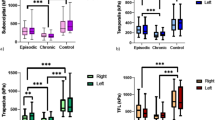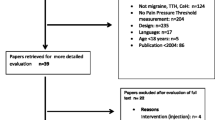Abstract
Aims
Studies evaluating sensory function of the entire trigeminocervical region in patients with cluster headache (CH), migraine (MH), and tension-type headache (TH) are required. The purpose of the present study was to evaluate and compare sensory function in the trigeminocervical region in patients with CH, MH, and TH and healthy controls (HC).
Methods
Quantitative sensory testing (QST), including pressure pain threshold (PPT), tactile detection threshold (TDT), prick detection threshold (PDT), and two-point detection threshold (2PDT), was evaluated in 139 patients with headache (CH = 16, MH = 52, TH = 71) and 30 HC. Test sites included bilaterally the first, second, and third divisions of trigeminal nerve (V1, V2, and V3), cervical spine, and thenar eminence.
Results
TH presented significantly lower PPT values compared with CH (p < 0.015), MH (p < 0.048), and HC (p < 0.009), while MH demonstrated significantly lower values than HC (p = 0.001–0.023). When analyzing TDT, CH in the symptomatic side presented significantly higher values in V1 compared with MH (p = 0.001), TH (p < 0.001), and HC (p < 0.001) and in V2 compared with TH (p = 0.035). No statistically significant differences were found for PDT (p > 0.005). With regard to 2PDT, CH-s presented significantly higher values in V1 with respect to HC (p = 0.016) but lower values in V2 compared with MH (p < 0.001) and TH (p = 0.003).
Conclusion
The results of the present study indicate specific and different altered mechanical sensory thresholds in CH, MH, and TH patients compared with HC subjects.

Similar content being viewed by others
Availability of data and materials
The datasets analyzed during the current study are available from the corresponding author on a reasonable request.
References
D'Amico D, Grazzi L, Usai S, Leonardi M (2013) Disability and quality of life in headache: where we are now and where we are heading. Neurol Sci 34(Suppl 1):S1–S5
Abu Bakar N, Tanprawate S, Lambru G, Torkamani M, Jahanshahi M, Matharu M (2016) Quality of life in primary headache disorders: a review. Cephalalgia 36(1):67–91
Linde M, Gustavsson A, Stovner LJ, Steiner TJ, Barré J, Katsarava Z, Lainez JM, Lampl C, Lantéri-Minet M, Rastenyte D, Ruiz de la Torre E, Tassorelli C, Andrée C (2012) The cost of headache disorders in Europe: the Eurolight project. Eur J Neurol 19(5):703–711
Reddy SM, Vergo MT, Paice JA, Kwon N, Helenowski IB, Benson AL et al (2016) Quantitative sensory testing at baseline and during cycle 1 oxaliplatin infusion detects subclinical peripheral neuropathy and predicts clinically overt chronic neuropathy in gastrointestinal malignancies. Clin Colorectal Cancer 15(1):37–46
Kitaj MB, Klink M (2005) Pain thresholds in daily transformed migraine versus episodic migraine headache patients. Headache 45(8):992–998
Schytz HW, Olesen J (2016) Laboratory tests of headache disorders - dawn of a new era? Cephalalgia 36(13):1268–1290
Pfau DB, Geber C, Birklein F, Treede RD (2012) Quantitative sensory testing of neuropathic pain patients: potential mechanistic and therapeutic implications. Curr Pain Headache Rep 16(3):199–206
Chua NH, Vissers KC, Wilder-Smith OH (2011) Quantitative sensory testing may predict response to sphenopalatine ganglion pulsed radiofrequency treatment in cluster headaches: a case series. Pain Pract 11(5):439–445
Burstein R, Yarnitsky D, Goor-Aryeh I, Ransil BJ, Bajwa ZH (2000) An association between migraine and cutaneous allodynia. Ann Neurol 47:614–624
Fernández-de-las-Peñas C, Madeleine P, Caminero AB, Cuadrado ML, Arendt-Nielsen L, Pareja JA (2010) Generalized neck-shoulder hyperalgesia in chronic tension-type headache and unilateral migraine assessed by pressure pain sensitivity topographical maps of the trapezius muscle. Cephalalgia 30(1):77–86
Ladda J, Straube A, Förderreuther S, Krause P, Eggert T (2006) Quantitative sensory testing in cluster headache: increased sensory thresholds. Cephalalgia 26:1043–1050
Komiyama O, De Laat A (2005) Tactile and pain thresholds in the intra- and extra-oral regions of symptom-free subjects. Pain 115:308–315
Komiyama O, Obara R, Iida T, Wang K, Svensson P, Arendt-Nielsen L, de Laat A, Kawara M (2012) Influence of age and gender on trigeminal sensory function and magnetically evoked masseteric exteroceptive suppression reflex. Arch Oral Biol 57:995–1002
Rolke R, Magerl W, Campbell KA, Schalber C, Caspari S, Birklein F, Treede RD (2006) Quantitative sensory testing: a comprehensive protocol for clinical trials. Eur J Pain 10:77–88
Vriens JPM, van der Glas HW (2009) Extension of normal values on sensory function for facial areas using clinical tests on touch and two-point discrimination. Int J Oral Maxillofac Surg 38:1154–1158
Vriens JPM, van der Glas HW (2002) The relationship of facial two-point discrimination to applied force under clinical test conditions. Plast Reconstr Surg 109:943–952
Mukaka MM (2012) Statistics corner: a guide to appropriate use of correlation coefficient in medical research. Malawi Med J 24(3):69–71
Vetvik KG, MacGregor EA (2017) Sex differences in the epidemiology, clinical features and pathophysiology of migraine. Lancet Neurol 16:76–87
Dong Z, Di H, Dai W, Pan M, Li Z, Lian J et al (2014) Clinical profile of cluster headaches in China - a clinic-based study. J Headache Pain 14:27
D’Andrea G, Gucciardi A, Perini F, Leon A (2019) The role of neurotransmitters and neuromodulators in the pathogenesis of cluster headache: a review. Neurol Sci 40:39–44
Edwards RR, Sarlani E, Wesselmann U, Fillingim RB (2005) Quantitative assessment of experimental pain perception: multiple domains of clinical relevance. Pain 114:315–319
Ellrich J, Ristic D, Yekta SS (2006) Impaired thermal perception in cluster headache. J Neurol 253(10):1292–1299
Coppola G, Di Lorenzo C, Bracaglia M, Di Lenola D, Parisi V, Perrotta A et al (2014) Lateralized nociceptive blink reflex habituation deficit in episodic cluster headache: correlations with clinical features. Cephalalgia 35(7):600–607
Rozen TD, Haynes GV, Saper JR, Sheftell FD (2005) Abrupt onset and termination of cutaneous allodynia (central sensitization) during attacks of SUNCT. Headache 45:153–155
Rozen TD, Fishman RS (2012) Cluster headache in the United States of America: demographics, clinical characteristics, triggers, suicidality, and personal burden. Headache 52:99–113
Taga A, Russo M (2019) Trigeminal autonomic cephalalgias: spectrum or continuum? Insights from a family. Neurol Sci 40:195–196
May A, Leone M, Boecker H, Sprenger T, Juergens T, Bussone G, Tolle TR (2006) Hypothalamic deep brain stimulation in positron emission tomography. J Neurosci 26:3589–3593
Rapoport AM, Edvinsson L (2019) Some aspects on the pathophysiology of migraine and a review of device therapies for migraine and cluster headache. Neurol Sci 40:75–80
Malick A, Strassman AM, Burstein R (2000) Trigeminohypothalamic and reticulohypothalamic tract neurons in the upper cervical spinal cord and caudal medulla of the rat. J Neurophysiol 84:2078–2112
Olesen J, Burstein R, Ashina M, Tfelt-Hansen P (2009) Origin of pain in migraine: evidence for peripheral sensitization. Lancet Neurol 8:679–690
Ashina S, Bendtsen L, Ashina M, Magerl W, Jensen R (2006) Generalized hyperalgesia in patients with chronic tension-type headache. Cephalalgia 26:940–948
Rosso C, Felisati G, Bulfamante A, Pipolo C (2019) Cluster headache: crosspoint between otologists and neurologists – treatment of the sphenopalatine ganglion and systematic review. Neurol Sci 40:137–146
Ashina S, Babenko L, Jensen R, Ashina M, Magerl W, Bendtsen L (2005) Increased muscular and cutaneous pain sensitivity in cephalic region in patients with chronic tension-type headache. Eur J Neurol 12:543–549
Manzoni GC, Camarda C, Genovese A, Quintana S, Rausa F, Taga A, Torelli P (2019) Cluster headache in relation to different age groups. Neurol Sci 40:9–13
Malo-Urriés M, Hidalgo-García C, Estébanez-Demiguel E, Tricás-Moreno JM, Santos-Lasaosa S, Jahanshahi M (2018) Sensory function in cluster headache: an observational study comparing the symptomatic and asymptomatic sides. Neuropsychiatr Dis Treat 14:3363–3371
Cua AB, Wilhelm KP, Maibach HI (1990) Elastic properties of human skin: relation to age, sex, and anatomical region. Arch Dermatol Res 282(5):283–288
Schenk LAM, Andrasik F (2019) Behavioral and psychological aspects of cluster headache: an overview. Neurol Sci 40:3–7
Kallai I, Barke A, Voss U (2004) The effects of experimenter characteristics on pain reports in women and men. Pain 112:142–147
Acknowledgments
We are thankful to our colleagues Andoni Carrasco Uribarren and Sara Cabanilas Barea who provided expertise that greatly assisted the research.
Funding
No funding has been obtained..
Author information
Authors and Affiliations
Contributions
MMU designed the study and wrote the first manuscript. EEM performed statistical analysis and wrote the manuscript. EEM, JMT, EBG, and CHG performed patient measurements and revised the manuscript. SSL recruited patients and revised the manuscript.
Corresponding author
Ethics declarations
Conflict of interest
The authors declare that they have no conflict of interest.
Ethical approval
Ethics approval and consent to participate have been obtained (Comité Ético de Investigación Clínica de Aragón (CEICA).
Informed consent
None
Additional information
Publisher’s note
Springer Nature remains neutral with regard to jurisdictional claims in published maps and institutional affiliations.
Rights and permissions
About this article
Cite this article
Malo-Urriés, M., Estébanez-de-Miguel, E., Bueno-Gracia, E. et al. Sensory function in headache: a comparative study among patients with cluster headache, migraine, tension-type headache, and asymptomatic subjects. Neurol Sci 41, 2801–2810 (2020). https://doi.org/10.1007/s10072-020-04384-8
Received:
Accepted:
Published:
Issue Date:
DOI: https://doi.org/10.1007/s10072-020-04384-8




